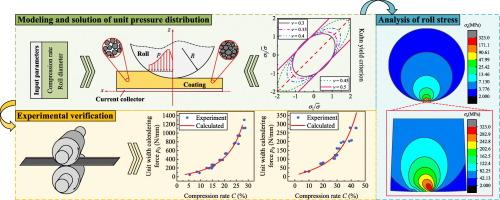锂离子电池电极压延过程中单元压力分布建模及轧辊应力分析
IF 8.9
2区 工程技术
Q1 ENERGY & FUELS
引用次数: 0
摘要
压延是锂离子电池制造的关键步骤,其工艺参数的精确控制对电极结构和电池性能有重要影响。然而,现有的研究缺乏一个完善的理论模型,可以准确地预测压延力和单位压力分布。为了填补这一空白,基于库恩屈服准则建立了预测单位压力分布的机理模型,并通过实验测量进一步验证了该模型的有效性。在此基础上,分析了辊缝内单位压力分布的特点。研究了压缩率和轧辊直径对单位宽度压延力和单位压力分布的影响。并将得到的单位压力作为边界条件,对轧辊应力进行了分析。研究了电极压延过程中轧辊的应力分布特征,评估了压缩率和轧辊直径对轧辊内最大von Mises应力的影响。所建立的模型和相应的发现为优化电池电极压延工艺提供了有益的见解,并为相关制造设备的设计提供了指导。本文章由计算机程序翻译,如有差异,请以英文原文为准。

Modeling of unit pressure distribution and roll stress analysis during lithium-ion battery electrode calendering
Calendering is a critical manufacturing step for lithium-ion batteries, where precise control of process parameters significantly influences the electrode structure and battery performance. However, existing studies lack a well-established theoretical model that can accurately predict the calendering force and unit pressure distribution. To fill this gap, a mechanistic model was developed based on the Kuhn yield criterion to predict the unit pressure distribution, which was further validated through experimental measurements. Building upon this model, the characteristics of unit pressure distribution within the roll gap were analyzed. The effects of the compression rate and roll diameter on the unit width calendering force and unit pressure distribution were also investigated. Furthermore, the obtained unit pressure was used as a boundary condition to analyze roll stress. The study focused on the roll stress distribution characteristics during the electrode calendering, and the influences of compression rate and roll diameter on the maximum von Mises stress within the roll were evaluated. The proposed model and corresponding findings provide useful insights for optimizing the calendering process of battery electrodes and offer guidance for the design of related manufacturing equipment.
求助全文
通过发布文献求助,成功后即可免费获取论文全文。
去求助
来源期刊

Journal of energy storage
Energy-Renewable Energy, Sustainability and the Environment
CiteScore
11.80
自引率
24.50%
发文量
2262
审稿时长
69 days
期刊介绍:
Journal of energy storage focusses on all aspects of energy storage, in particular systems integration, electric grid integration, modelling and analysis, novel energy storage technologies, sizing and management strategies, business models for operation of storage systems and energy storage developments worldwide.
 求助内容:
求助内容: 应助结果提醒方式:
应助结果提醒方式:


